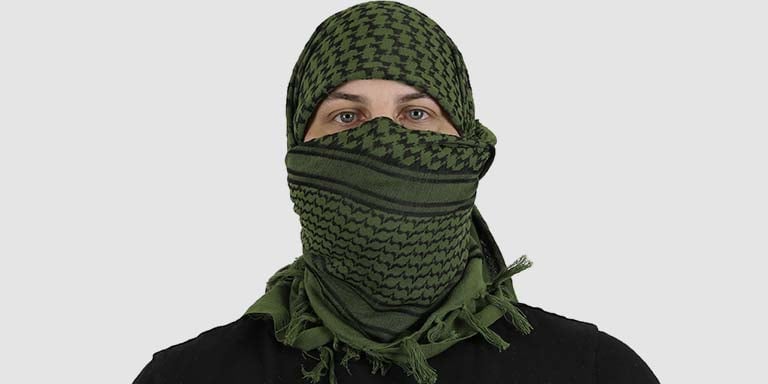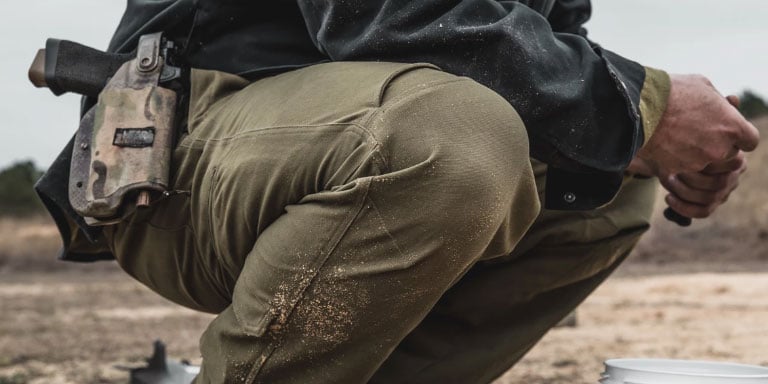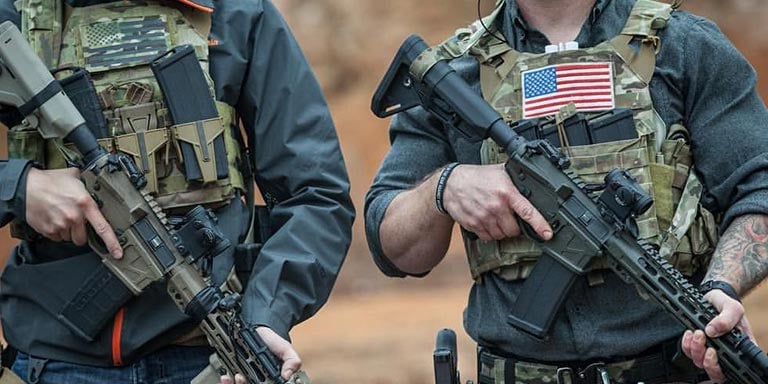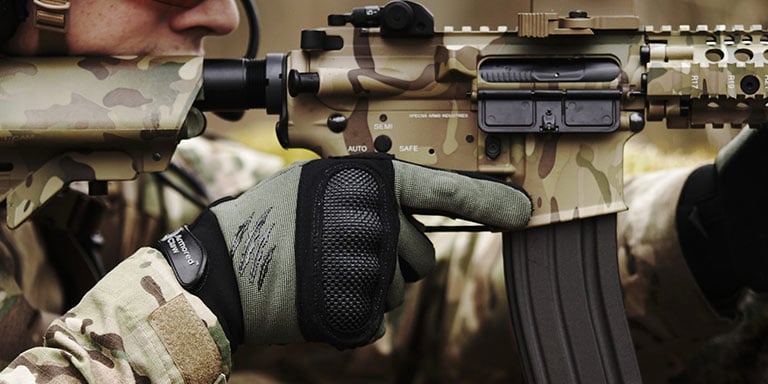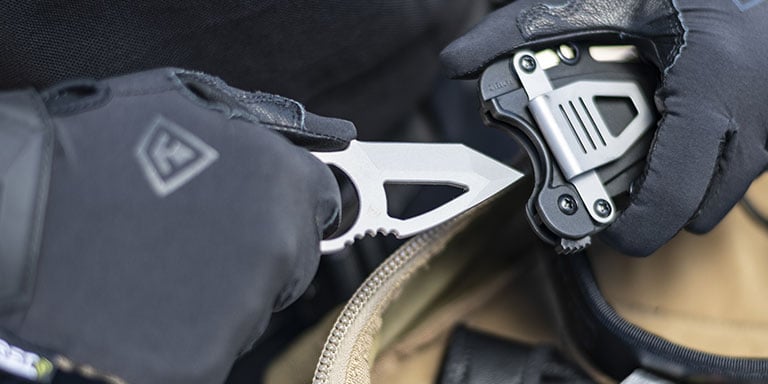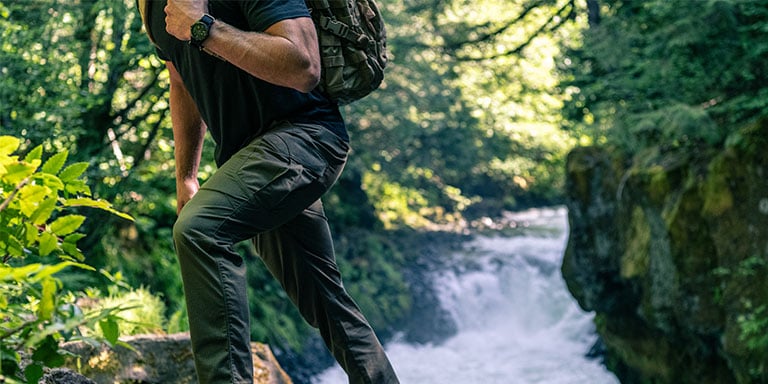
Selecting the right backpack is important. Your bag needs to be the perfect size to accommodate all your gear — not too big, not too small. It needs to be comfortable, durable, and have the functionality to allow you to store your essentials efficiently. With so many features, styles and sizes to choose from, finding the right backpack can be overwhelming without the proper help. We put together the definitive guide to help you navigate all your options in order to find the perfect tactical backpack.
What Makes a Backpack Tactical?
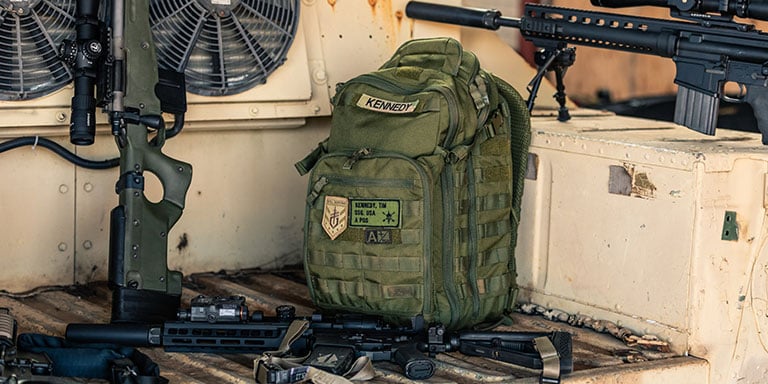
To understand what makes a backpack tactical, it helps to know what the word tactical means. Tactical backpacks are made with military-inspired utility in mind. They come with features that originated in the armed forces like hydration pack compatibility, MOLLE webbing (Modular Lightweight Load-carrying Equipment) and ammunition pouches. All of these features are meant to offer distinct combat advantages. They're also made with a militaristic appearance, featuring colors like coyote brown, olive drab or camouflage patterns. These colorways, just like the patterns on military uniforms, are designed to help conceal troops in specific operating environments.
Tactical Backpack Sizes
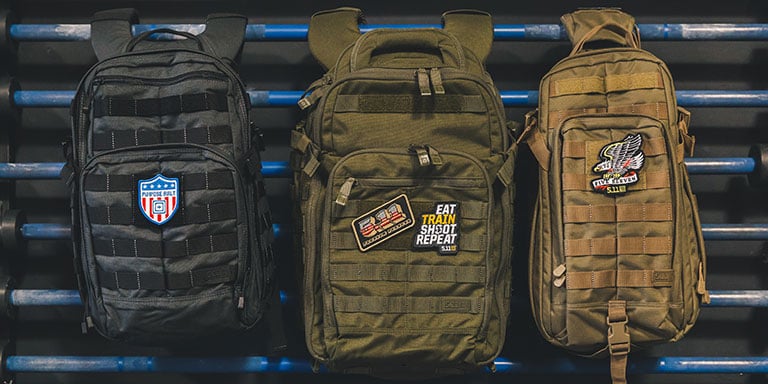
Not all tactical backpacks are the same size; their volume varies, and while some bags are pretty small, others can be quite large. The volume of an object is the measurement of its length multiplied by the measurement of its width and height. Tactical backpacks are often measured in cubic inches, but an easier way to think about backpack size is in terms of liters. Since most packs are not perfect rectangles, liters more accurately represent their size. On the lower end, backpacks usually start at around 5 liters, with larger options of 60 liters or more. Below is a general guideline for choosing the size of your backpack.
EDC Packs
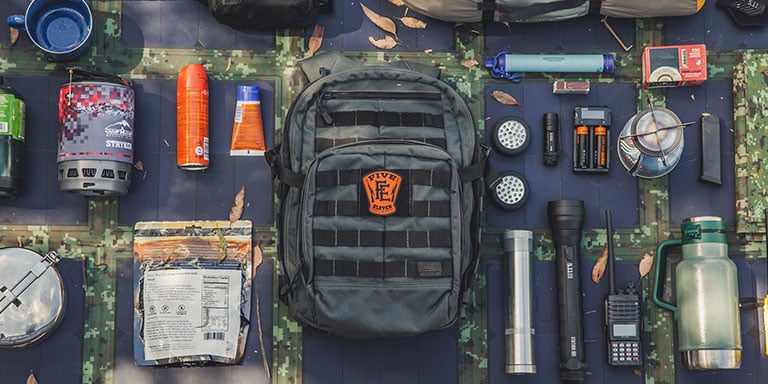
Everyday carry (or EDC) bags are small tactical backpacks designed to hold only the essential items you need to take with you day to day. Sometimes EDC packs are referred to as 12 hour packs. These backpacks vary in size from about 5 to 35 liters. Shop EDC Tactical Backpacks
24 Hour Backpacks
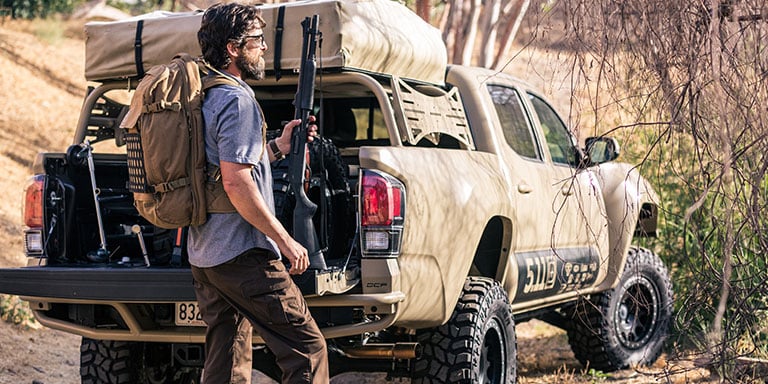
An EDC backpack is made to carry enough gear to get you through your typical day. When you plan on being gone overnight though, you'll need something a little bigger. A 24 hour pack is large enough to accommodate even more gear for longer assignments. These tactical backpacks are generally 30 to 40 liters in volume. Shop 24 Hour Backpacks
3 Day Backpacks

If you're planning on being gone for an extended period of time, it would be wise to take along a 3 day backpack. These packs can fit everything you may need over the course of multiple days and have many of the same features as backpacking packs. Bags of this type are very large, typically 40 to 65 liters in volume or more. Shop 3 Day Tactical Backpacks
Load Management
Tactical backpacks aren't simply designed to carry a lot — they're also designed to carry intuitively. Poor load management can result in high fatigue and even serious injuries. Therefore, it is absolutely vital to understand how to carry your gear properly. Here are some load management features on tactical backpacks and how to effectively utilize them.
Shoulder Straps
Shoulder straps are the foundation for carrying any backpack. You'll want to be sure they are adjustable for a custom fit. There are different styles of shoulder straps to consider which affect the ergonomics of your pack.
-
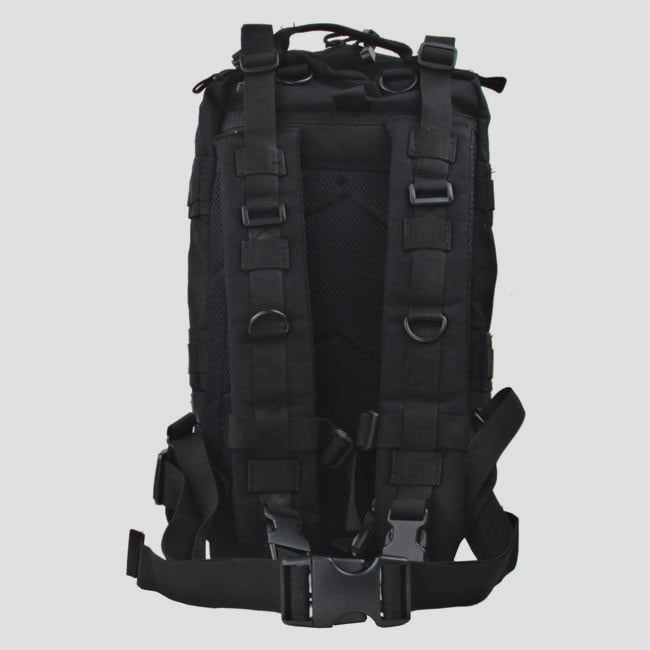
Straight Shoulder Straps
Straight shoulder straps are the least common type of shoulder straps on tactical backpacks. They prioritize appearance over functionality and don't provide a very ergonomic fit. They are usually large, though, so they have plenty of space for padding to maximize comfort. -
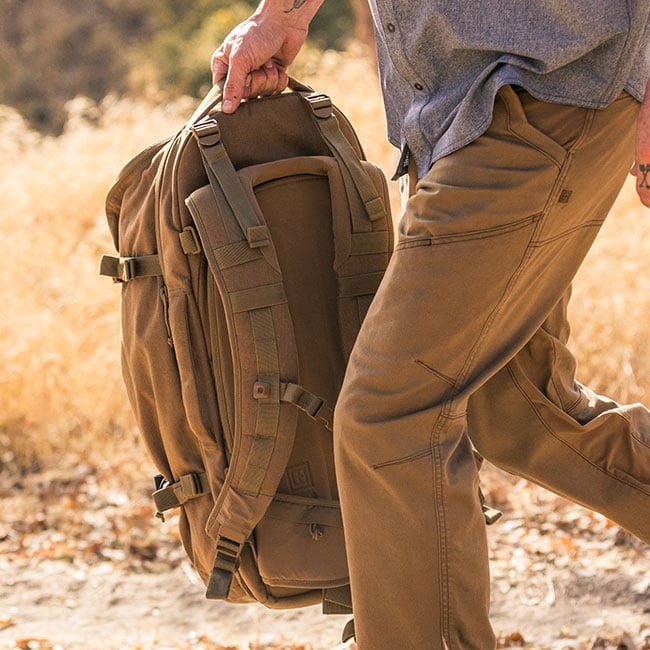
Curved Shoulder Straps
Curved shoulder straps are by far the most common type of shoulder straps. They are designed to emulate the natural shape of the body for a nice, ergonomic fit. These straps will almost always come with plenty of padding and adjustability. -

One-Piece Shoulder Straps
Connected to each other between the shoulder blades, one-piece shoulder straps are made with durability in mind. The bridge between the two straps provides plenty of surface area for the straps to attach to the bag, making them unlikely to become unattached.
-
Sternum Straps
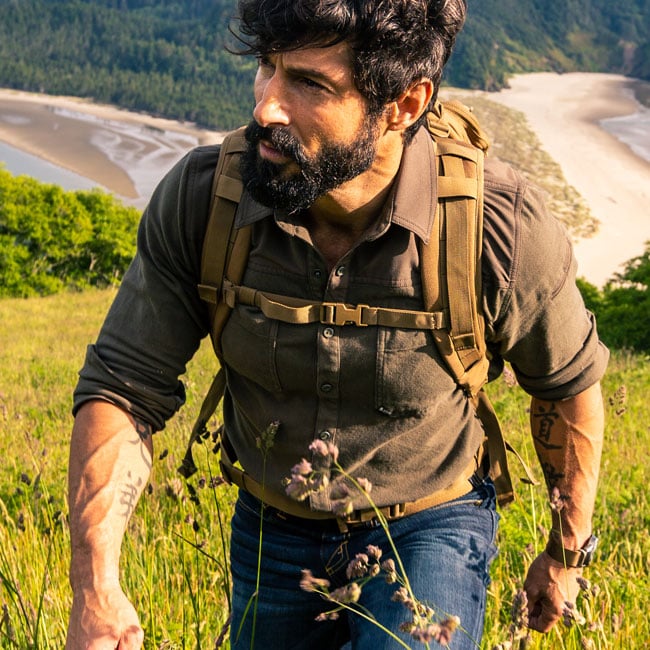
As you add weight to your pack, a sternum strap helps to provide more comfort and stability. This additional strap changes the way weight is dispersed across your chest and shoulders for better load management. It will also prevent your pack from swinging when negotiating obstacles or rough terrain. This added balance is important in curtailing fatigue.
-
Hip Belts
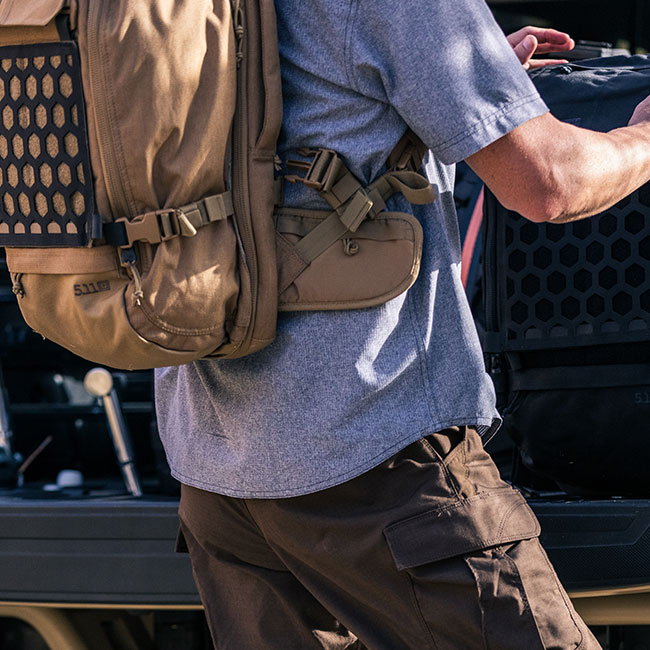
When pack weight starts to surpass twenty pounds, additional load management features become necessary to effectively operate over long distances. Hip belts help to transfer the weight of a heavy pack from your back and shoulders to your hips. Adjust the backpack so the padded section of the hip belt is hugging the top of your hips. Called the iliac crest, this location on your torso will utilize your core strength to carry the pack's weight more efficiently. This principle of transferring weight to your hips is more than just ergonomics — you will be able to ruck heavier weights faster and further while expending less energy than carrying the full load on your shoulders.
Frames

Backpack frames work in conjunction with a hip belt to further optimize the physics involved in transferring weight from your shoulders to your core. They do this by adding rigidity to the pack's structure or with components attaching directly to the hip belt. As each additional component ultimately adds weight to your pack, frames are typically constructed with very lightweight materials.
Frame Sheets
Frame sheets are typically used on smaller packs as a lightweight option to provide rigidity. A simple piece of plastic placed in a pack's back panel helps the pack keep its shape when stuffed with gear. This helps to relieve pressure on the shoulders and aids in the overall weight distribution of the pack.
Internal Frame
Internal frames are common in larger packs where a simple frame sheet is inadequate for the weight being carried. Usually made from aluminum rods called stays, these frames are built into the backpack itself and will attach directly to the hip belt. These stays are even more effective at transferring the load from the shoulders to the hips.
External Frame
External frame backpacks pre-date internal frame options and are less common today. As their name implies, these packs are constructed with the frame on the outside. One benefit of this design is the ability to strap items directly to the frame. This is very useful when packing out game or carrying unwieldy items. Though typically heavier than internal frame packs, this purpose-built design is often superior for certain tasks.
Compression Straps
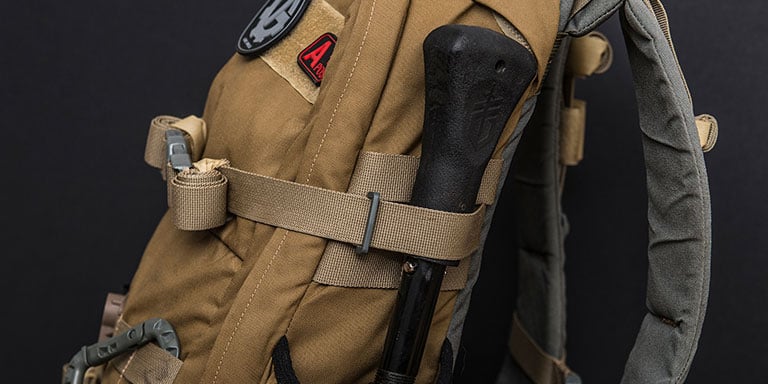
Found on the side of a tactical backpack, compression straps allow for a bag to be flattened or expanded depending on the size of the load. It's always advantageous to carry weight closer to the body, and compression straps help to tamp down a half-full bag to eliminate excess space. Compressing a pack closer to your body allows for increased balance, better load management, and a more comfortable overall carrying experience.
Rear Loading Straps
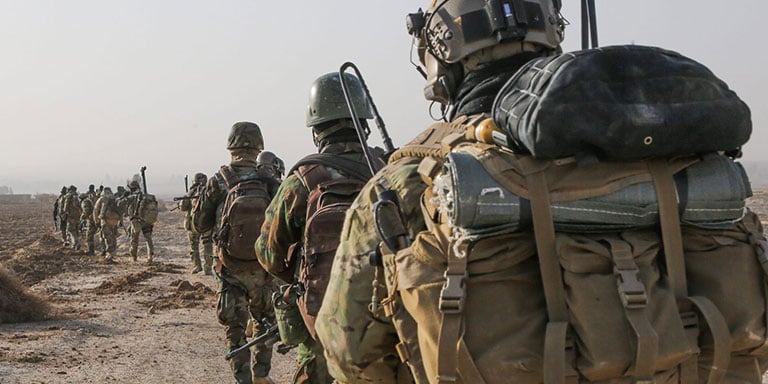
Rear loading straps are found on the back, and often bottom of a backpack. Their purpose is to secure items that are too large to fit in the main compartment like a sleeping bag or a blanket. When using rear loading straps, be sure to balance the gear on which you're using them with the rest of your load.
Side Loading Straps

Side loading straps provide even more opportunity to store gear outside of a backpack's main compartments. Again, the key when using these straps is to make sure your load is still balanced when everything is secured.
Access and Opening Styles
The primary purpose of a tactical backpack is to store your gear and make it easier to carry. Just as important, however, is how you get to your gear. There are many different access and opening styles a tactical backpack might have. Each style is designed with accessibility in mind and comes with its own unique set of advantages. Here are some of the most common types.
-

Splayed
Splayed openings allow a backpack's compartments to fan out when unzipped. This provides easy, immediate access to the contents inside each compartment. Great for staying organized, splayed openings allow for separation between large and small items. -
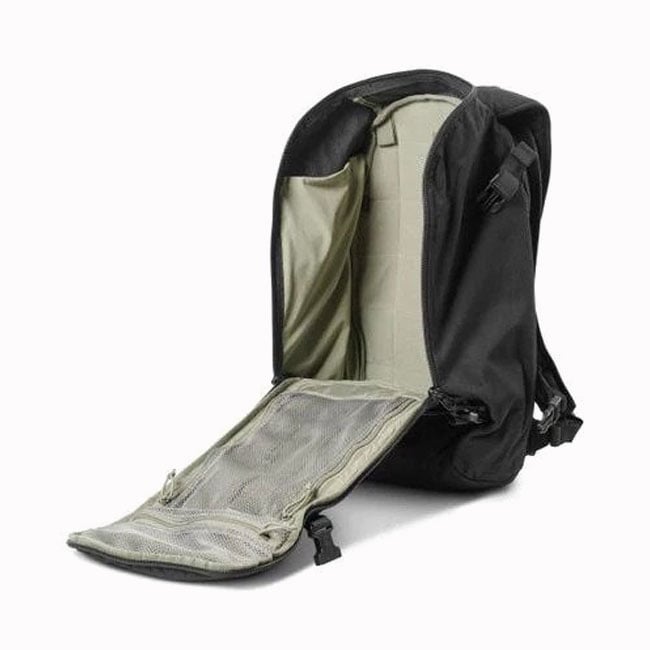
Clamshell
Clamshell packs feature a zippered opening on three sides with a single side attached to the pack that acts as a hinge. Organizational channels and pockets within the main compartment allow items to be grouped as needed to prevent the main pocket from becoming messy. -
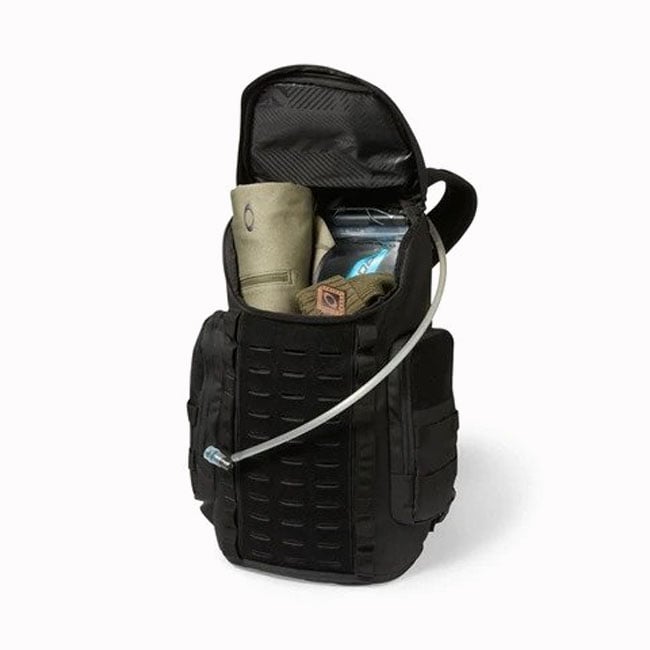
Top Access
Top access openings allow for the retrieval of belongings from the top down. This access style helps to ensure that gear stays packed in tightly without accidentally spilling out as long as the bag remains upright. -

Y-Access
Popularized by Mystery Ranch, the y-access (or 3-zip) opening style allows the entire front of the backpack to open up, offering efficient access to gear. Highly versatile, this opening style is popular among experienced backpackers. -
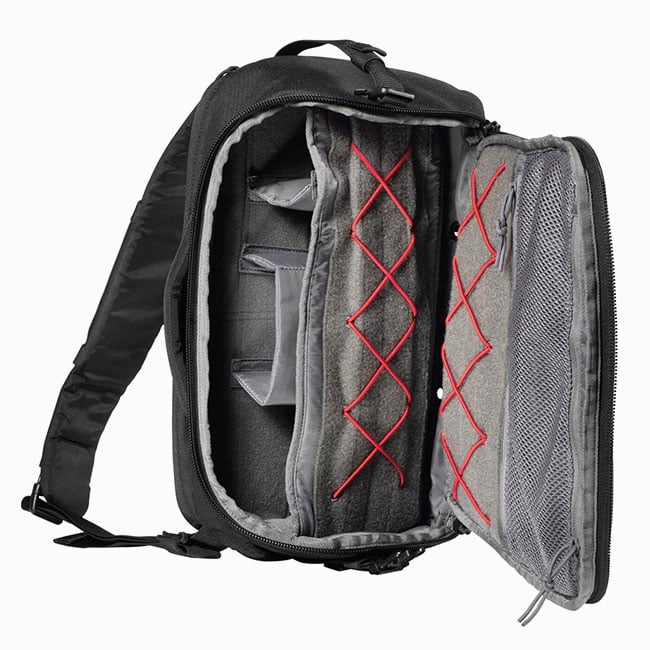
Front Access
Instead of providing access from the top like most backpacks, the front access style places a zipper vertically along the front of the bag. Offering compartmentalized access to specific sets of items, this opening style is perfect for those who prioritize organization. -
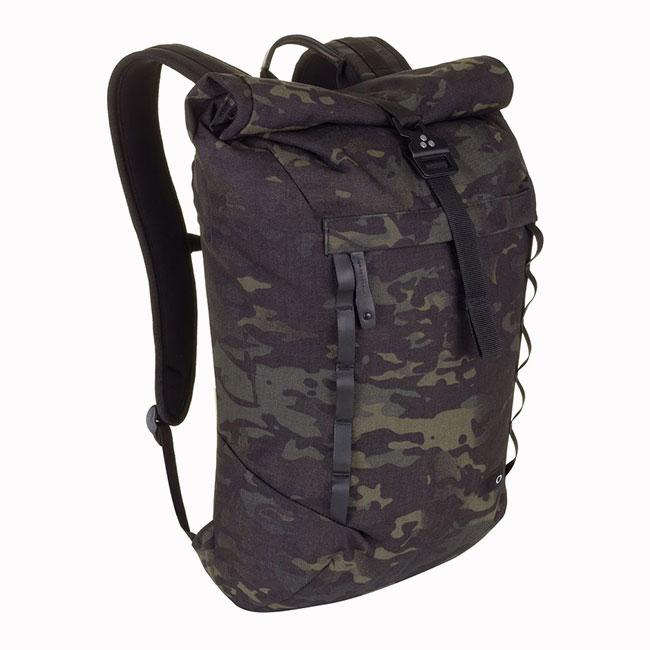
Rolltop
As its name suggests, rolltop tactical backpacks feature a top flap that rolls up like a dry bag and typically closes shut with a buckle. Rolltop backpacks are exceptionally water-resistant and good to use when weather may be an issue. -

Side Access
Side access zippers are typically a secondary opening style, good for grabbing something from the bottom of a backpack without disturbing the other contents. Backpacks with side access can be swung around and opened like a sling bag for fast, convenient access to gear.
Organization

Organization is another important aspect of a tactical backpack. When packing gear, you shouldn't simply throw things into your pack randomly. It's best to stow belongings intuitively so you'll have access to items in the order in which you'll need or use them. There are plenty of ways to organize your gear to ensure easy, uninhibited access.
Pockets
Pockets are the easiest way to organize your gear. They allow you to separate things by size, use or significance for quick and convenient access. The following are some common organizational pockets and provisions in a tactical backpack.
-

Main Compartment
The main compartment is the largest section of the pack. Typically accessed by a zipper, the main compartment holds the largest and most important gear and comprises the bulk of a backpack's volume. -
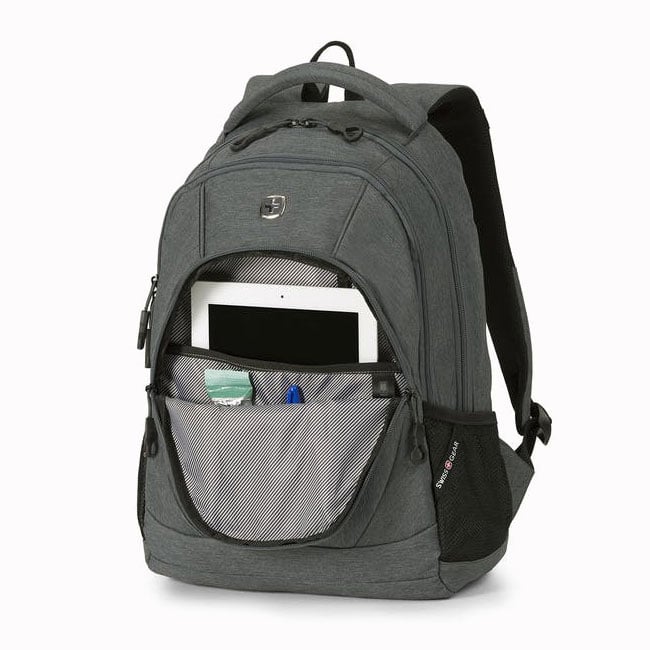
Secondary Compartment
The secondary compartment is normally in front of the main compartment. This compartment contains smaller, lighter gear or overflow from the main compartment. Secondary compartments often contain small pockets and mesh organizers inside. -
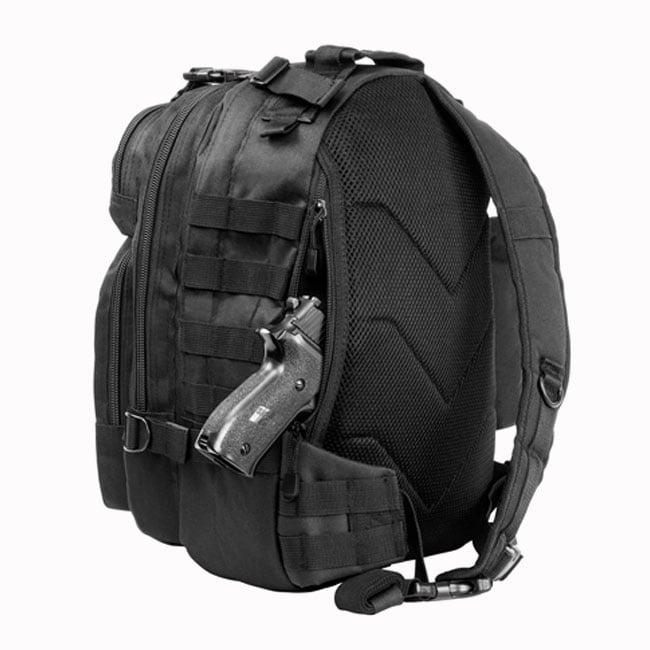
CCW Compartment
Because it's difficult to wear a holster and draw a gun while carrying a backpack, the CCW compartment is made specifically to accomodate a weapon. These pockets are designed for discreet storage and quick access to a gun and ammo. -

Laptop Sleeve
Most people own and need to transport a laptop. Backpack manufacturers have responded by creating a specific pocket to accommodate one. These sleeves offer fast, convenient access to a tablet or laptop while providing padded protection for the device. -
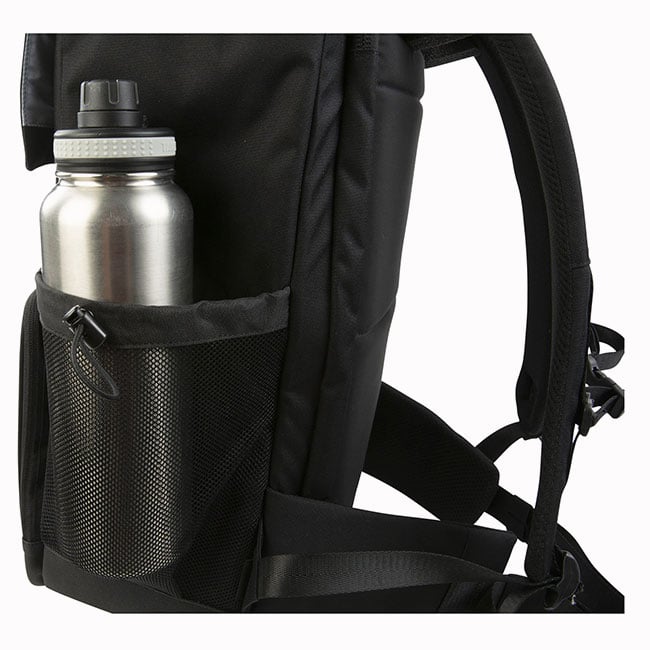
Mesh Pockets
Mesh pockets are common both on the inside and outside of a backpack. On the outside, these pockets typically hold a water bottle. When they're on the inside, they're great for storing smaller gear. They're transparent, making it easy to see their contents. -
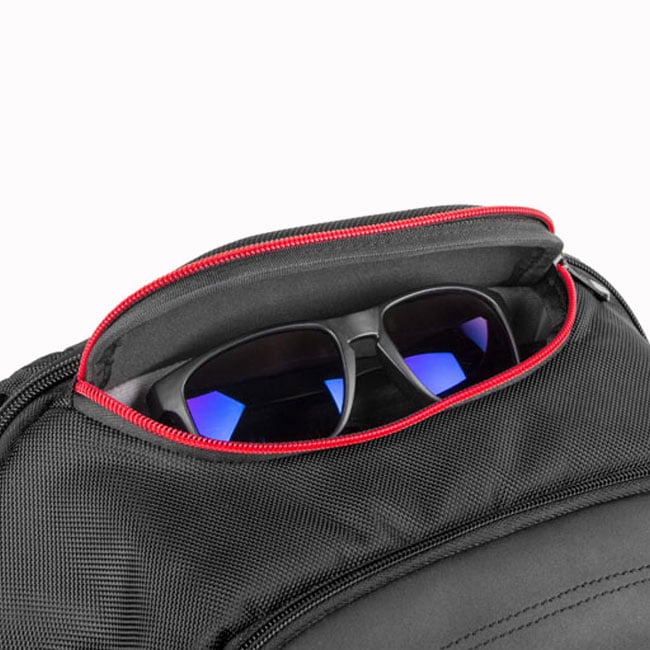
Glasses Pouch
If you're without a case, a lot of tactical backpacks have a pouch attached to the main compartment to store your eyewear. Often lined with microfiber fabric, these pouches prevent fragile glasses from being crushed by the other contents of the backpack. -
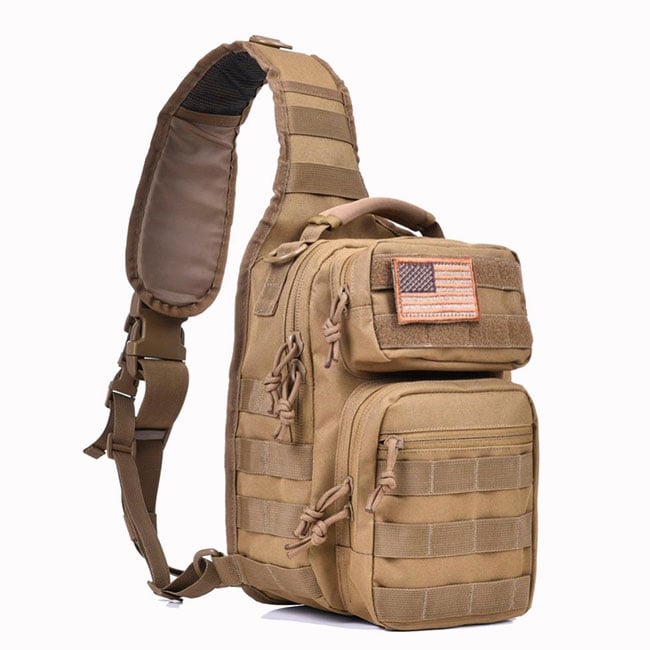
Velcro Fields
Many tactical backpacks come with loop velcro fields to accommodate patches with hook velcro fields. These patches provide occupational identification for police, EMS workers or military members. Other patches are made with humorous, morale-boosting messages. Shop Morale Patches -
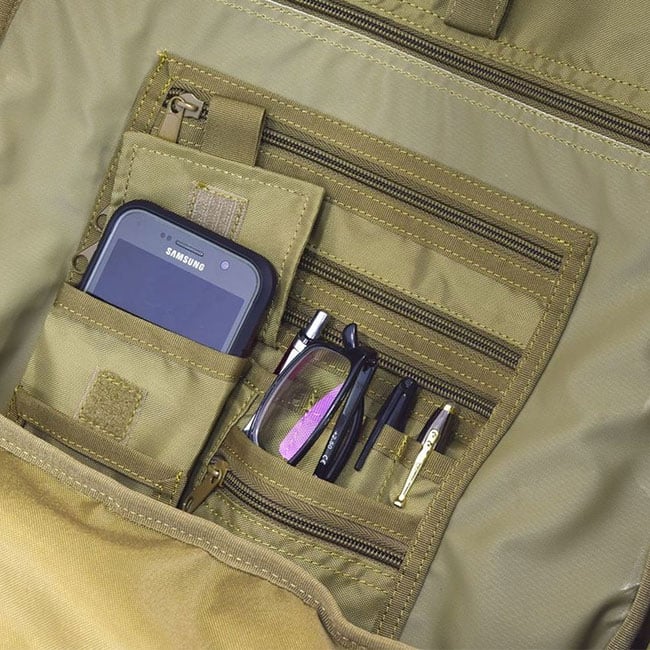
Pen Slots
Small items like pens are bound to fall to the bottom of a bag and get lost under bulkier gear. To solve this problem, many tactical backpacks come with pen slots, or specific pockets for pens and smaller items so they don't become lost near the bottom. -

Document Pouches
Document pouches are great for stowing identification papers, notebooks and even maps for when cell phone reception is bad. These pockets are placed to protect important papers from being folded or torn under the weight of other gear.
Molle Webbing
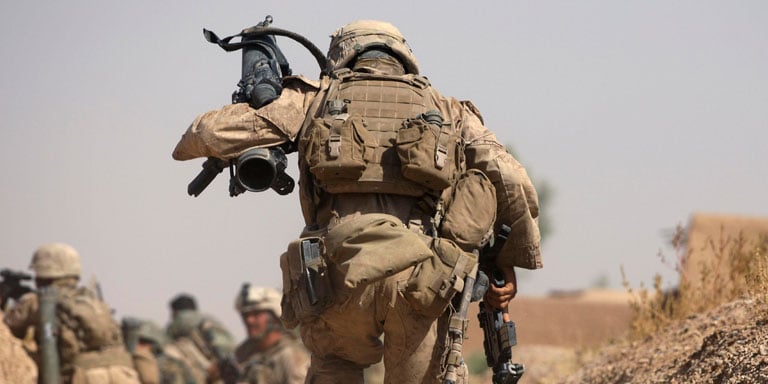
Modular Lightweight Load-carrying Equipment webbing, or MOLLE, was introduced in the 1990s and is used widely by the United States military. MOLLE is a system of loops sewn onto a plate carrier or backpack that fits other MOLLE compatible gear. As the U.S. Armed Forces began using gear with MOLLE webbing, the trend found its way into tactical backpacks to offer civilians the same level of organizational utility.
MOLLE webbing is typically used for adding storage pouches to a pack. These pouches provide immediate access to gear you may need right away like magazines, radios, phones and flashlights. Instead of having to stop, remove your pack, unzip it and dig for extra ammunition, a pouch allows you to simply reach back, grab and reload. Retrieving important gear quickly can make all the difference when you're under pressure. Shop Tactical Pouches
MOLLE webbing provides a customized and versatile carrying experience. If a pack's main and secondary compartments become overcrowded with gear, MOLLE webbing offers the opportunity for extra storage space on the outside of the backpack. It is important to be strategic when adding provisions to your pack with MOLLE webbing. The extra pouches and pockets should be attached in such a way that your gear is still accessible, organized and balanced. Take a look at our guide on how to use MOLLE to learn how to attach pouches and other provisions to your backpack.
Hydration Bladders

When carrying heavy loads, it's important to stay hydrated. That can often be tough to do — not all backpacks have provisions for water bottles, and a water bottle stored inside a pack cannot be accessed without stopping. A solution to this hydration problem, especially popular among members of the U.S. military, is using a backpack with a hydration bladder.
Hydration bladders are very popular in tactical backpacks. These rubber reservoirs rest within the backpack itself and can hold multiple liters of water at a time. A hose runs from the bladder through a channel in the backpack, and drinking from it is as simple as drawing the hose's bite valve up to your mouth. Hydration packs allow travelers to carry an easily accessible, hassle-free water supply that can last all day. In case you're very lost and without water, be sure to learn how to find water in a survival situation. Shop Hydration Compatible Tactical Backpacks
Materials

Tactical backpacks are used primarily by military members and law enforcement officers to help them organize, transport and protect their gear. These backpacks are likely to see a lot of rough treatment in the course of duty. As a result, they are made of the toughest materials available so they don't rip or fall apart during critical situations. Here are some common materials out of which tactical backpacks are typically made.
Cordura
Cordura is a tough fabric that is resistant to scuffs, abrasions and tears. It has been used by the U.S. military for over 45 years for its incredible durability. It can be found in footwear, combat shirts, pants, jackets and, of course, backpacks.
Ballistic nylon
Its name alone does well to establish ballistic nylon's toughness. Developed by Dupont and used in World War II flak jackets to protect airmen from shrapnel, this thick fabric is incredibly resilient. Outside of backpacks, many knife sheaths, belts and watch bands are made from ballistic nylon.
Ripstop
Ripstop fabrics, as their name implies, are resistant to ripping and tearing. While ripstop fabrics may not be as tough as cordura or ballistic nylon, they still provide above-average durability while remaining lightweight and thin (and, therefore, more comfortable).
Polyester
Used primarily in clothing, polyester doesn't provide the same level of resilience as ballistic nylon or cordura. It is remarkably light, however, meaning that a tactical backpack with polyester is more comfortable and easy to carry while still offering adequate durability.
In short, there is no perfect or best tactical backpack. Choosing your optimal backpack comes down to personal necessity and the activities you're planning on doing with your bag. There's a wide range of options to consider when shopping for a tactical backpack. Being knowledgeable and selective about these options is the best way to decide which bag to pick.
Did you find this article helpful?


